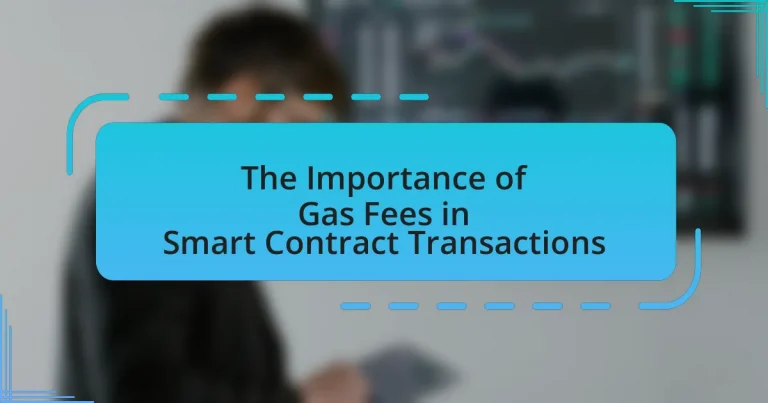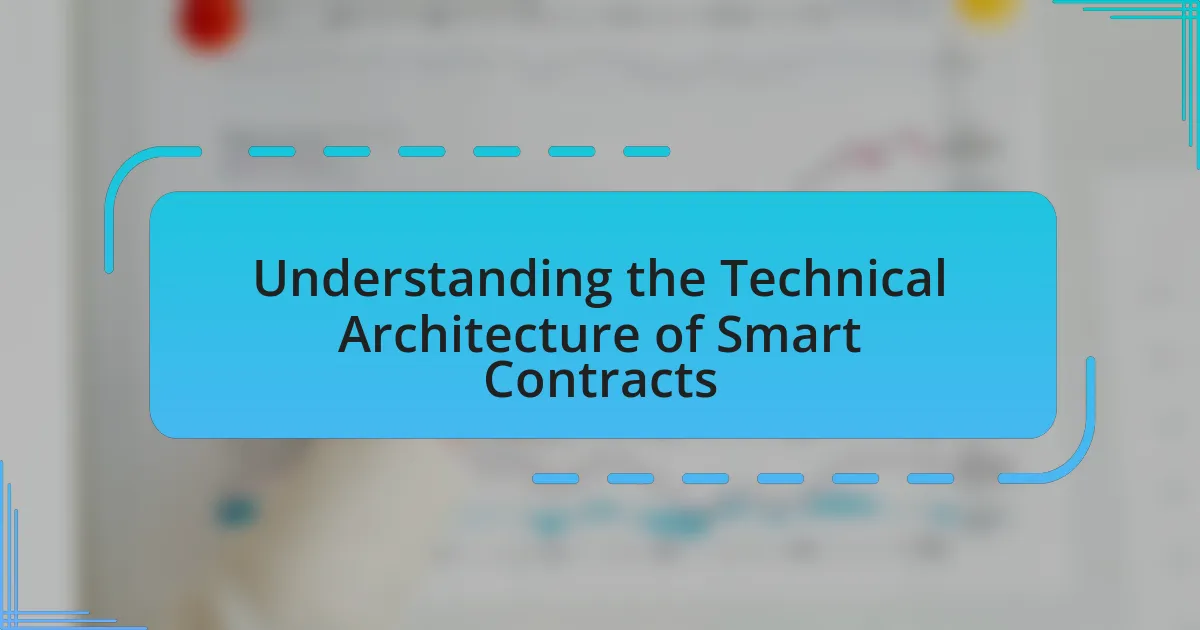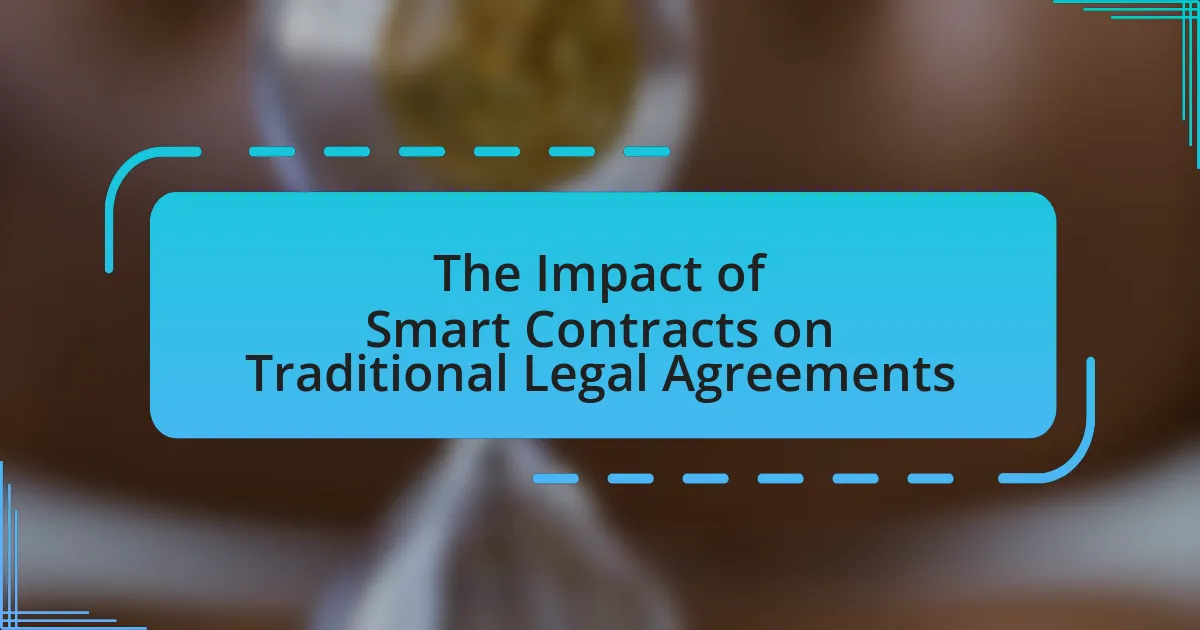Gas fees are essential costs associated with executing operations on blockchain networks, particularly in smart contract transactions. This article explores the calculation of gas fees, the factors influencing their amounts, and their critical role in transaction validation and smart contract functionality. It also addresses the implications of gas fees for users and developers, strategies for optimizing transactions, and future trends in gas fee management, including the impact of layer 2 solutions. Understanding gas fees is crucial for navigating the blockchain ecosystem effectively, as they significantly affect transaction costs, speed, and overall user experience.
What are Gas Fees in Smart Contract Transactions?
Gas fees in smart contract transactions are the costs associated with executing operations on a blockchain network. These fees compensate miners or validators for the computational resources required to process and validate transactions. For example, on the Ethereum network, gas fees are measured in Gwei, a denomination of Ether, and fluctuate based on network demand and transaction complexity. The necessity of gas fees ensures that the network remains secure and operational, as they incentivize participants to maintain the blockchain’s integrity.
How are gas fees calculated in smart contracts?
Gas fees in smart contracts are calculated based on the computational resources required to execute a transaction and the current network demand. Each operation within a smart contract has a specific gas cost, which is determined by the complexity of the operation, such as storage access or arithmetic calculations. The total gas fee is then computed by multiplying the gas price, which is set by the market and can fluctuate based on network congestion, by the total gas used for the transaction. For example, if a transaction requires 21,000 gas units and the gas price is 50 Gwei, the total fee would be 1,050,000 Gwei, or 0.00105 ETH. This calculation ensures that users pay for the resources consumed during the execution of their smart contracts.
What factors influence the gas fee amount?
Gas fee amounts are influenced primarily by network congestion, transaction complexity, and the gas price set by users. Network congestion occurs when many transactions are being processed simultaneously, leading to higher fees as users compete to have their transactions prioritized. Transaction complexity refers to the computational resources required to execute a transaction; more complex transactions consume more gas, resulting in higher fees. Additionally, users can set their own gas prices, which can fluctuate based on demand and urgency, further impacting the overall gas fee.
How do network congestion and demand affect gas fees?
Network congestion and demand directly increase gas fees in blockchain transactions. When more users attempt to execute transactions simultaneously, the limited capacity of the network leads to competition for processing space. This competition drives up the price of gas, as users are willing to pay higher fees to prioritize their transactions. For instance, during peak times, such as significant market events or popular NFT drops, gas fees can surge dramatically, sometimes exceeding hundreds of dollars, as seen on the Ethereum network. This relationship between congestion, demand, and gas fees is a fundamental aspect of how blockchain networks manage transaction throughput and incentivize miners or validators to process transactions efficiently.
Why are gas fees essential for smart contract functionality?
Gas fees are essential for smart contract functionality because they incentivize miners to process and validate transactions on the blockchain. Without gas fees, miners would lack motivation to allocate their computational resources, leading to delays or failures in executing smart contracts. The Ethereum network, for example, requires gas fees to prioritize transactions, ensuring that those willing to pay higher fees are processed more quickly, which maintains the efficiency and reliability of the network.
What role do gas fees play in transaction validation?
Gas fees serve as a mechanism to prioritize and validate transactions on blockchain networks. They incentivize miners or validators to include a transaction in the next block by compensating them for the computational resources required to process it. Higher gas fees typically result in faster transaction validation, as miners are more likely to select transactions with greater fees to maximize their earnings. This system ensures that the network remains efficient and secure, as it discourages spam transactions and allocates resources to those willing to pay for quicker processing.
How do gas fees impact the execution of smart contracts?
Gas fees directly impact the execution of smart contracts by determining the cost and speed of transaction processing on blockchain networks. Higher gas fees incentivize miners to prioritize the execution of transactions, leading to faster confirmation times, while lower gas fees may result in delayed processing or even transaction failures if the fees are insufficient. For example, during periods of high network congestion, such as the Ethereum network’s peak usage times, gas fees can surge significantly, affecting users’ ability to execute smart contracts promptly. This dynamic illustrates the critical role gas fees play in ensuring efficient and timely execution of smart contracts within decentralized applications.
What are the implications of gas fees on users and developers?
Gas fees significantly impact both users and developers by influencing transaction costs and network efficiency. For users, high gas fees can deter participation in blockchain activities, as they may lead to increased costs for executing transactions or interacting with smart contracts. This can result in reduced user engagement and limit the accessibility of decentralized applications. For developers, fluctuating gas fees complicate the budgeting and pricing of services, as they must account for variable costs when designing applications. Additionally, high gas fees can hinder the adoption of their projects, as potential users may be discouraged by the expense associated with using their applications. Overall, gas fees play a crucial role in shaping user behavior and developer strategies within the blockchain ecosystem.
How do gas fees affect user experience in decentralized applications?
Gas fees significantly impact user experience in decentralized applications by influencing transaction speed and cost. High gas fees can deter users from executing transactions, as they may find the costs prohibitive, leading to decreased engagement with the application. For instance, during periods of network congestion, Ethereum gas fees have surged to over $100 per transaction, causing users to delay or abandon their activities. Conversely, lower gas fees enhance user experience by facilitating quicker and more affordable transactions, thereby encouraging greater participation in decentralized platforms. This relationship between gas fees and user behavior is critical for the adoption and usability of decentralized applications.
What challenges do high gas fees present to users?
High gas fees present significant challenges to users by increasing the cost of executing transactions on blockchain networks. These elevated fees can deter users from participating in decentralized applications, as they may find the costs prohibitive compared to the value of the transactions. For instance, during periods of network congestion, gas fees can spike dramatically, sometimes exceeding $100 for a single transaction on Ethereum, which can lead to users abandoning their transactions altogether. This situation not only limits access for smaller investors but also creates a barrier to entry for new users, ultimately hindering the growth and adoption of blockchain technology.
How can users optimize their transactions to minimize gas fees?
Users can optimize their transactions to minimize gas fees by timing their transactions during periods of lower network congestion. Gas fees fluctuate based on network demand; for instance, during peak times, fees can increase significantly. By monitoring network activity and choosing to transact when fewer users are active, such as weekends or off-peak hours, users can take advantage of lower gas prices. Additionally, users can set gas limits and use gas price estimation tools to find the most cost-effective rates for their transactions, ensuring they do not overpay.
What strategies can developers employ to manage gas fees?
Developers can manage gas fees by optimizing smart contract code, using layer 2 solutions, and implementing gas-efficient algorithms. Optimizing smart contract code reduces the computational complexity, which directly lowers gas consumption; for instance, minimizing storage operations can significantly decrease costs. Layer 2 solutions, such as Polygon or Optimistic Rollups, allow transactions to occur off the main Ethereum chain, resulting in lower fees and faster processing times. Additionally, employing gas-efficient algorithms, like those that minimize the number of transactions or batch operations, can further reduce the overall gas fees incurred during transactions.
How can developers design efficient smart contracts to reduce gas costs?
Developers can design efficient smart contracts to reduce gas costs by optimizing code and minimizing storage usage. Efficient coding practices, such as using smaller data types and avoiding unnecessary computations, can significantly lower the gas required for execution. Additionally, reducing the number of state variables and utilizing mappings instead of arrays can decrease storage costs, which are a major contributor to gas fees. For instance, Ethereum’s gas costs are directly linked to the complexity of operations and the amount of data stored, with storage operations costing 20,000 gas units. By implementing these strategies, developers can create more cost-effective smart contracts that operate efficiently within the blockchain ecosystem.
What tools are available for monitoring and estimating gas fees?
Tools available for monitoring and estimating gas fees include EthGasStation, GasNow, and Etherscan. EthGasStation provides real-time gas price data and historical trends, allowing users to make informed decisions about transaction timing. GasNow offers a user-friendly interface that displays current gas prices and estimates for transaction confirmation times. Etherscan, a widely used blockchain explorer, also features a gas tracker that shows current gas prices and provides insights into network congestion. These tools are essential for users engaging in smart contract transactions, as they help optimize costs and improve transaction efficiency.
What are the future trends regarding gas fees in smart contract transactions?
Future trends regarding gas fees in smart contract transactions indicate a potential decrease in costs due to advancements in blockchain technology and scalability solutions. Layer 2 solutions, such as Optimistic Rollups and zk-Rollups, are being developed to process transactions off the main blockchain, significantly reducing congestion and lowering gas fees. Additionally, the Ethereum network’s transition to a proof-of-stake consensus mechanism aims to enhance efficiency and reduce energy consumption, which could further stabilize or decrease gas fees. Historical data shows that during periods of high network activity, gas fees have surged, but as more efficient protocols are adopted, the volatility in gas prices may diminish, leading to a more predictable fee structure for users.
How might blockchain technology evolve to address gas fee issues?
Blockchain technology may evolve to address gas fee issues through the implementation of layer 2 scaling solutions, such as rollups and state channels. These solutions enable transactions to be processed off the main blockchain, significantly reducing congestion and lowering fees. For instance, Ethereum’s rollups can bundle multiple transactions into a single one, which decreases the overall gas fees for users. Additionally, the introduction of more efficient consensus mechanisms, like proof of stake, can also lower transaction costs by improving network efficiency. Historical data shows that during peak usage times, gas fees on Ethereum have surged to over $70 per transaction, highlighting the need for such innovations to enhance scalability and affordability in smart contract transactions.
What innovations are being developed to lower gas fees?
Innovations being developed to lower gas fees include Layer 2 scaling solutions, such as Optimistic Rollups and zk-Rollups, which process transactions off the main blockchain to reduce congestion and costs. These technologies enable faster transaction processing and significantly lower fees by bundling multiple transactions into a single one before submitting them to the main chain. For instance, Ethereum’s Optimism and zkSync have demonstrated reductions in gas fees by up to 90% compared to on-chain transactions. Additionally, the implementation of EIP-1559 introduced a base fee mechanism that adjusts dynamically based on network demand, further optimizing gas costs.
How could layer 2 solutions impact gas fees in the future?
Layer 2 solutions could significantly reduce gas fees in the future by enabling transactions to occur off the main blockchain, thereby alleviating congestion. These solutions, such as rollups and state channels, process multiple transactions in batches before submitting them to the main chain, which minimizes the overall demand for on-chain space. For instance, Ethereum’s rollup technology has demonstrated the ability to increase throughput while lowering costs, as seen in projects like Optimism and Arbitrum, which have successfully reduced gas fees by up to 90% during peak times. This reduction in fees can enhance the usability of smart contracts, making them more accessible for everyday transactions and fostering broader adoption of decentralized applications.
What best practices should users follow to navigate gas fees effectively?
To navigate gas fees effectively, users should monitor network congestion and choose optimal transaction times. By observing the Ethereum network’s gas tracker, users can identify periods of lower activity, which typically result in reduced fees. Additionally, users should set gas limits and prices manually to avoid overpaying, as automated settings may not always reflect current market conditions. Research indicates that transactions executed during off-peak hours can save users up to 50% on gas fees compared to peak times.
How can users stay informed about gas fee fluctuations?
Users can stay informed about gas fee fluctuations by utilizing real-time tracking tools and platforms that provide updates on current gas prices. Websites like Gas Station Network and EthGasStation offer live data on Ethereum gas fees, allowing users to monitor changes and make informed decisions about transaction timing. Additionally, many cryptocurrency wallets and decentralized applications integrate gas fee estimators that alert users to fluctuations before they initiate transactions, ensuring they can optimize their costs effectively.
What tips can help users choose the right time for transactions?
To choose the right time for transactions, users should monitor gas fees and network congestion. Gas fees fluctuate based on demand; lower fees typically occur during off-peak hours, such as late nights or weekends. Historical data shows that Ethereum gas prices can drop significantly during these times, often by 50% or more compared to peak hours. Additionally, utilizing tools like gas trackers can provide real-time insights into current fees, helping users make informed decisions.



